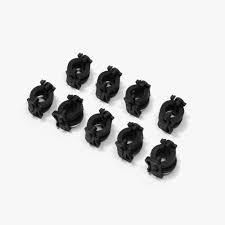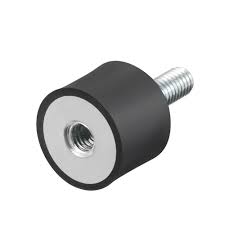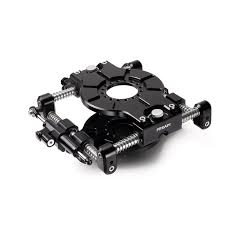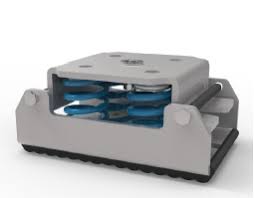Seismic isolators have become an essential component in maximizing building safety, especially in regions prone to high levels of seismic activity. These innovative devices are designed to minimize the impact of ground shaking from earthquakes, thereby reducing the risk of structural damage and collapse. In this rubber vibration isolator mounts article, we will explore the role of seismic isolators in enhancing building safety and their importance in mitigating the potential devastation caused by seismic events.
Seismic isolators vibration isolator mounts are devices that are used to minimize the impact of ground motion during an earthquake on buildings and other structures. These isolators are typically placed at the base of the building and work by allowing the foundation to move independently from the structure above. This helps to reduce the transfer of seismic forces to the building, thus minimizing the potential for damage. By using seismic isolators, building safety can be maximized by significantly reducing the risk of structural damage and collapse during an earthquake. This technology has been proven to be effective in protecting buildings and their occupants from the destructive forces of seismic activity. In addition to safeguarding lives and property, seismic isolators also provide economic benefits by reducing the need for extensive repairs and reconstruction following an earthquake. In regions prone to seismic activity, implementing seismic isolators in building design and construction is a critical step towards enhancing overall safety and resilience. This technology has been successfully utilized in a wide range of structures, including high-rise buildings, bridges, and infrastructure facilities, and continues to play a vital role in mitigating the impact of earthquakes on the built environment.
Seismic isolators are devices designed to reduce the impact of ground motion during earthquakes on buildings and other structures. They are placed at the base of a building, allowing the foundation to move independently from the structure above. This minimizes the transfer of seismic forces to the building, thereby decreasing the risk of structural damage and collapse during an earthquake. Seismic isolators not only protect lives and property but also reduce the need for extensive repairs and reconstruction following seismic events. This technology has been successfully used in various floor mount vibration isolator structures, such as high-rise buildings and bridges, to enhance overall safety and resilience in earthquake-prone areas.
Understanding the Role of Seismic Isolators in Building Structures

Seismic isolators are devices installed in building structures to minimize the impact of seismic waves during an earthquake. They work by providing a buffer between the building and the ground, allowing the building to move independently of the ground motion. This helps to reduce the transfer of seismic forces to the building, thereby preventing or reducing damage. Seismic isolators can be made from various materials such as rubber, steel, or lead-rubber bearings. They are strategically placed at the base of a building or structure and are designed to absorb and dissipate seismic energy, thus providing stability and protection during an earthquake. By understanding the role of seismic isolators in building structures, engineers and architects can design and construct more resilient buildings that are better able to withstand the forces of an earthquake. This ultimately leads to safer and more secure built environments for people living and working in seismically active areas.
The Evolution of Seismic Isolators in Earthquake-Prone Regions

The evolution of seismic isolators in earthquake-prone regions has seen a progression from simple passive systems to more advanced and sophisticated technologies. Seismic isolators are designed to protect structures and infrastructure from the damaging effects of seismic activity by allowing them to move independently of the ground motion. Early isolators were typically made of rubber and lead, while modern designs may incorporate advanced materials such as high-damping rubber, steel, or elastomeric bearings. The development of these technologies has been driven by a growing understanding of seismic behavior and advances in engineering and materials science. As a result, seismic isolators have become an important tool in mitigating the impact of earthquakes on buildings and critical infrastructure in earthquake-prone regions.
Important Factors to Consider When Choosing Seismic Isolators
hvac vibration isolation

Some important factors to consider when choosing seismic isolators include the type of building or structure that requires isolation, the expected level of seismic activity in the area, the required level of protection for the structure and its contents, and the desired level of maintenance and longevity for the isolators. Additionally, the compatibility of the isolators with the structure's design, the cost of installation and ongoing maintenance, and the availability of technical support and expertise should also be taken into account. It is important to carefully evaluate these factors in order to select the most suitable seismic isolators for a specific application.
The Benefits of Retrofitting Buildings with Seismic Isolators

Retrofitting buildings with seismic isolators can significantly reduce the risk of damage and collapse during an earthquake. Seismic isolators help to absorb and dissipate the energy generated by seismic waves, thereby protecting the structural integrity of the building and minimizing the potential for injury or loss of life. Additionally, retrofitting with seismic isolators can also enhance the overall resilience of a building, potentially lowering insurance premiums and increasing property value. Overall, this seismic retrofitting method offers a cost-effective and scalable solution for improving the safety and stability of existing buildings in seismically active regions.
Innovative Designs of Seismic Isolators for Improved Safety
Seismic isolators are innovative devices designed to protect structures and their occupants during earthquakes by reducing the transmission of ground motion to the building. They work by allowing the building to move independently of the ground motion, thus dissipating energy and reducing seismic forces. Some common types of seismic isolators include base isolators, which are placed between the building and its foundation, and dampers, which absorb energy through the deformation of materials like steel or viscoelastic materials. Advancements in seismic isolator design have focused on improving their effectiveness, durability, and cost-efficiency. For example, researchers have developed innovative shape memory alloy-based isolators that can provide high damping capacity and rapid force recovery after an earthquake. Other developments include the use of advanced materials such as carbon fiber reinforced polymers and high-damping rubber bearings to enhance the performance of seismic isolators. Additionally, the integration of sensors and control systems has allowed for adaptive seismic isolation, where the characteristics of the isolators can be adjusted in real-time to optimize their performance during an earthquake. Overall, these innovative designs of seismic isolators contribute to improved safety and resilience of structures in earthquake-prone regions, offering a promising solution for mitigating the impact of seismic events on buildings and infrastructure.
How Seismic Isolators Help Mitigate the Impact of Ground Motion
Seismic isolators help mitigate the impact of ground motion by isolating a structure from the ground, allowing it to move independently in response to an earthquake. This helps to reduce the transfer of seismic energy to the building, decreasing the potential for structural damage. Seismic isolators work by absorbing and dissipating seismic forces, thereby improving the overall resilience of a structure during an earthquake. By incorporating seismic isolators into building design, engineers can significantly enhance the capacity of buildings to withstand seismic events.
The Importance of Regular Maintenance for Seismic Isolators
vibration isolation components
Regular maintenance for seismic isolators is crucial for ensuring the effectiveness of these devices in mitigating the impact of seismic activity on buildings and structures. Seismic isolators are designed to absorb and dissipate the energy generated by an earthquake, thereby protecting the structure from damage. Without regular maintenance, these isolators can deteriorate and lose their ability to perform effectively. This can result in an increased risk of structural damage and compromise the safety of the building during an earthquake. Therefore, it is essential to conduct regular inspections, testing, and maintenance of seismic isolators to ensure their proper function and the safety of the building and its occupants.
Case Studies of Successful Implementation of Seismic Isolators in Construction
One case study of successful implementation of seismic isolators in construction is the Transamerica Pyramid in San Francisco, California. The building, completed in 1972, used a combination of base isolation and tuned mass dampers to protect against earthquakes. During the 1989 Loma Prieta earthquake, the building experienced significantly less damage compared to surrounding structures without seismic isolation. Another example is the Tokyo Skytree in Japan, one of the tallest towers in the world. The tower is equipped with a seismic isolation system that incorporates a combination of high-damping rubber bearings and oil dampers. During the 2011 Tohoku earthquake, the tower remained structurally sound and continued to function without any significant damage. Furthermore, the Los Angeles City Hall underwent a retrofitting process that included the installation of seismic isolators in order to improve its earthquake resistance. The building has successfully withstood several major earthquakes since the completion of the retrofitting process. These case studies demonstrate the effectiveness of seismic isolation in protecting structures from the impacts of seismic events.
In conclusion, seismic isolators are a vital technology for maximizing building safety in seismic regions. By integrating these isolators into building design, engineers can effectively minimize the impact of earthquakes and protect both the structure and its occupants. Investing in seismic isolators is a proactive and effective way to enhance the resilience of buildings and ensure the safety of communities in earthquake-prone areas.
See also
https://www.dunavins.com/vibration-isolators https://www.karman-rubber.com/vibration-isolators.html https://www.lanpdt.com/vibration-isolation/